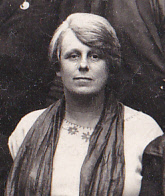 Mary Quaile was born in Dublin on 8 August 1886: her mother was Bridget Lightholder, her father was James Quaile, a mason and bricklayer. James was an active member of the Ancient Guild of Incorporated Brick and Stone Layers Trade Union, serving as Secretary for a time. The Quailes emigrated to England in 1889 or 1890. At the time of the census in April 1911, the family were living at 1 Pimlott Street in Longsight. In addition to Mary, who was the eldest, the census return listed four sons – John, William, Charles and James – and two daughters – Kathleen and Isabella.
Mary Quaile was born in Dublin on 8 August 1886: her mother was Bridget Lightholder, her father was James Quaile, a mason and bricklayer. James was an active member of the Ancient Guild of Incorporated Brick and Stone Layers Trade Union, serving as Secretary for a time. The Quailes emigrated to England in 1889 or 1890. At the time of the census in April 1911, the family were living at 1 Pimlott Street in Longsight. In addition to Mary, who was the eldest, the census return listed four sons – John, William, Charles and James – and two daughters – Kathleen and Isabella.
Mary left school aged 12, working as a domestic servant, which she later described as “by no means a bed of roses.” She went abroad, working in the French port of Brest for a time where she gained a working knowledge of French, a skill that no doubt later proved very useful at international trade union meetings. Back in Manchester she became enthused by trade unionism after the well-known trade union organiser Margaret Bondfield came to Manchester to organise women workers.
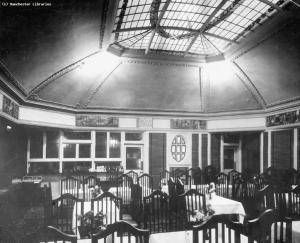 Mary started her trade union work after she got a job at the Clarion Café in Manchester. The café opened at 50a Market Street on 31 October 1908 and was part of the Clarion movement, inspired by the socialism preached by Robert Blatchford in the columns of The Clarion newspaper, which he had founded in December 1891. As well as a place to eat and drink (including vegetarian meals), the Clarion Café also offered a venue for political meetings and social events. The décor was by Walter Crane in the Arts and Crafts style
Mary started her trade union work after she got a job at the Clarion Café in Manchester. The café opened at 50a Market Street on 31 October 1908 and was part of the Clarion movement, inspired by the socialism preached by Robert Blatchford in the columns of The Clarion newspaper, which he had founded in December 1891. As well as a place to eat and drink (including vegetarian meals), the Clarion Café also offered a venue for political meetings and social events. The décor was by Walter Crane in the Arts and Crafts style
Mary was involved in the formation of a Manchester branch of the National Café Workers’ Union, founded in Liverpool by Mrs Billinge, who was a member of the local Fabian Society. The branch gathered a number of members in Manchester and consequently, on 8 November 1909, a meeting took place in the MWTUC offices at 9 Albert Square to set up a Manchester branch. Mrs Billinge was present and spoke about how the union had been formed. The first Secretary of this new branch was Miss Wild, but the following year Mary took over as Secretary, perhaps after a further meeting which took place in the Clarion Café on 8 June 1910 at which the speakers were Mrs Billinge, Mrs Ward and Olive Aldridge, Organising Secretary at MWTUC.
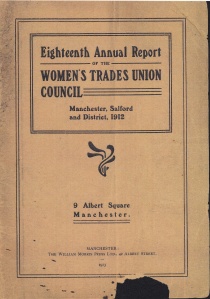 In March 1911 Mary got a job as Assistant Organising Secetary at the Manchester Women’s Trades Council, established in 1895 to organise low-paid, unorganised women workers. She worked alongside Olive Aldridge, the Organising Secretary. The two women worked very hard. in 1912, for instance, they attended over 100 meetings with women in different trades and also held 244 business meetings in the offices. The 1912 Annual Report noted that the office had become known as a place where working women could come for advice and assistance: “The commonest complaints brought are of excessive deductions for hot water, spoiled work, etc, of fines, of unfair dismissals and unjust distribution of work.”
In March 1911 Mary got a job as Assistant Organising Secetary at the Manchester Women’s Trades Council, established in 1895 to organise low-paid, unorganised women workers. She worked alongside Olive Aldridge, the Organising Secretary. The two women worked very hard. in 1912, for instance, they attended over 100 meetings with women in different trades and also held 244 business meetings in the offices. The 1912 Annual Report noted that the office had become known as a place where working women could come for advice and assistance: “The commonest complaints brought are of excessive deductions for hot water, spoiled work, etc, of fines, of unfair dismissals and unjust distribution of work.”
The MWTUC raised more than £900 to support women workers at Bradford Flax Mill, who were on strike for four months from October 1911 to February 1912. The workforce at the mill comprised about 300 workers, the majority of whom were women and girls. The dispute began when the women, who had recently become organised into the Flax Workers’ Union, asked for an increase in wages of two shillings a week.
Olive left due to ill-health and Mary became Organising Secretary at the beginning of the First World War. As thoudand sof womne repalced mne in industry, Mary and others worked very hard to ensure that women workers wer not exploited by employers who spouted patriotic slogans, but were eager to turn a profit out of the war. Personally Mary was a pacifist and member of the No-Conscription Fellowship where she was then living.
In April 1919 the two women’s trades councils in Manchester, which had now formed a good working relationship, merged with the Manchester and Salford Trades Union Council to form a single body. By now the Women’s Trades and Labour Council had 3,000 members, the Women’s Trades Union Council had 2,000 members. The women’s unions now became the Women’s Group of the Trades Council with Mary being appointed full time Secretary to this Group.
In November 1919 Mary was took up the post of National Women’s Organiser for the Dock, Wharf and Riverside Workers’ Union. She continued in this post when her union became part of the Transport and General Workers’ Union in 1922, the largest union in the country, and continued her work until 1933 when she retired due to ill-health.
In September 1921 Mary attended the annual Trades Union Congress for the first time as a delegate from her union. At the following Congress in 1922 Mary stood for the first time for one of two seats on the General Council of the TUC reserved for women. She came fourth after Margaret Bondfield (National Union of General Workers) and Julia Varley (Workers’ Union) who were both elected and Miss Howse (Post Office Workers). Margaret had been on the General Council since 1917, the first woman to be elected to that body.
In 1923 Mary stood again and this time came third in the ballot after Margaret Bondfield and Julia Varley. When Ramsay MacDonald appointed Margaret to a Cabinet post as Minister for Employment in January 1924 in the first Labour government she resigned from the General Council and Mary took her place as the runner-up, attending her first meeting in March. .
In May 1924 both Mary and Julia Varley attended the National Conference of Labour Women and then at the end of the month went to a conference of International Women Trade Unionists in Vienna where they were instructed by the General Council to maintain the position of the TUC, which was that women should be organised within the International Federation of Trade Unions, and not form a separate autonomous organisation. After the conference finished they stayed on in Vienna to attend the Third International Trade Union Congress. In November 1924 Mary was appointed by the General Council to be their representative on the new Women’s Advisory Committee of the International Federation of Trade Unions on which four other countries were represented:
Mary was elected again to the General Council in 1925, coming second to Margaret Bondfield, beating Julia Varley. In September 1926 Mary attended the first Annual Trade Union Women’s Conference held in Bournemouth at the same time as Congress, at which there was a good attendance from women trade unionists.
Mary toured the Soviet Union between April and July 1925 as chair of a delegation of four British women trade unionists who had a brief to investigate conditions for women and children. In addition to Mary, the delegates were Mrs A Bridge, an organiser in the National Union of Printing, Bookbinding and Paper Workers; Miss Annie Loughlin, an organiser in the Tailor and Garment Workers’ Union; and Miss L A Aspinall, an organiser in the Weavers, Winders and Reelers’ Association They were accompanied by Miss May Purcell, stenographer, and Mrs K Coates, interpreter.
During their stay Russian women trade unionists presented the British women with a banner. The slogan on the front of the banner reads “Workers of the World Unite. United Struggle of Russian and English Men and Women Workers Will Ensure World Victory of the Proletariat”. The banner shows two women against a backdrop of factories and Lenin’s tomb. The slogan on the reverse of the banner reads “To English Women Delegates of the General Council of Trade Unions. Long Live the Unity of the Trade Union Movement. The Women Trade unionists of Tvet, May 1925”. They were also given an album of photographs taken during their visit to take back to England. A surviving photograph shows them in Kislovodsk, a spa city in the North Caucasus region of Russia.
The General Strike was the most significant British industrial dispute of the twentieth century. It was a nation-wide solidarity action called by the TUC in support of the miners who had been locked out by the coal-owners after refusing to accept cuts in pay and longer hours. As the strike approached Mary spoke at the May Day procession and rally in Bristol on 1st May , organised by the local Trades and Labour Council.
The strike began at midnight on Monday 3rd May. On Sunday 9th May Mary spoke at a large rally in Platt Fields park, Manchester in support of the strike. A report on the meeting sent to the TUC estimated that there were at least 20,000 people present. Two brass bands made up of striking tramway workers led the procession into the park.
Stella Davies described it as a “large orderly crowd and the presence of many women and children with sandwiches and bottles of milk made it seem almost like a picnic….Towards the end of the meeting the speakers were encouraging, promising victory if ‘all stood together’ and the crowd dispersed in good heart”.
In 1934 Mary became a Justice of the Peace in Manchester. In 1936 she was elected Vice-President of Manchester Trades Council, the first woman officer of the Council, and from 1936 to 1958 she acted as the Treasurer. In 1951 she was awarded the TUC Silver Badge which was given to Trades Council officers who had held office consecutively for 21 years. Mary was the first woman trade unionist to receive this medal, which was presented to her by Sir Luke Fawcett on behalf of the TUC at a dinner and social evening at Belle Vue Gardens, attended by 400 people. Arthur Deakin, General Secretary of the TGWU, sent a message of congratulation.
Her great niece Jane Ennis recalls Mary later years:
Our father, John Ennis, grew up in Manchester with his mother, Kathleen (Kitty) Ennis, (Mary’s sister) and Mary Quaile (his Aunt Lol.) In later years, the two sisters lived together in Withington. As children, we would visit them and occasionally they would make the trip to London to see us. I recall that they often wore matching dresses and once gave a startling performance of the Beverley Sisters song, Sisters! As a child, I remember being struck by the friendliness of their Manchester household. Every tradesman seemed to come in for a cup of tea, the coalman sitting on a sheet of newspaper. During the time when we knew Mary, she was suffering from Parkinson’s, and although she had pronounced tremors, she was still revered in the community, holding court in the front parlour and sorting out people’s problems while our gran (Kitty) supported the household with a night time cleaning job at the offices of the Manchester Guardian.
Mary died at her home in Withington on 16th December 1958. The Manchester Guardian carried her obituary the following day, noting that:
…her determination to get trade unionism for women accepted was often met with jeers, boos, rotten apples, and threats of violence. She spoke at hundreds of factory gate meetings in both the East End of London and Manchester; she never betrayed any sign of fear when faced with hostility. Her warmth and lovable personality won for her many friends in the labour and trade union movement.
Manchester Trades Council, in its annual report for 1958-1959, said that Mary had “a vast knowledge and experience” in trade union affairs and the movement had suffered a great loss. After she had been compelled by illness to retire from her national office she had given all her time in voluntary service to the Trades Council:
She never relinquished her post as Hon.Treasurer, nor did the Council wish her to do so, even though her Doctor had compelled her not to leave the house. Whenever she had a visitor from the Trades Council her face would beam with delight. Any news or information about the affairs of the Movement she was able to glean on these occasions were to her a tonic; to her the Trade Union Movement was her life.
For five decades Mary never swerved from her belief that the best way for working women to improve their lives at work was through trade unionism. She dedicated her life to this cause and for this she deserves to be remembered – and celebrated.

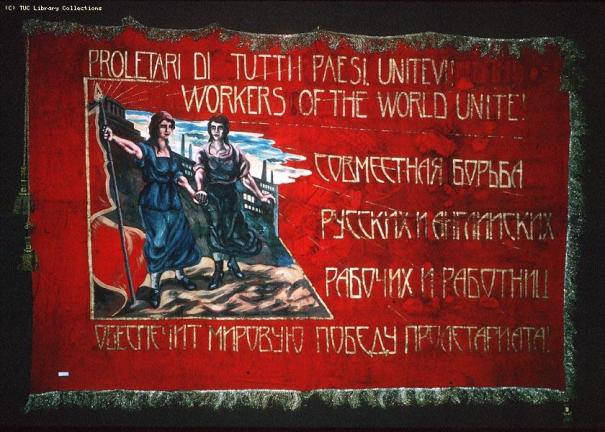
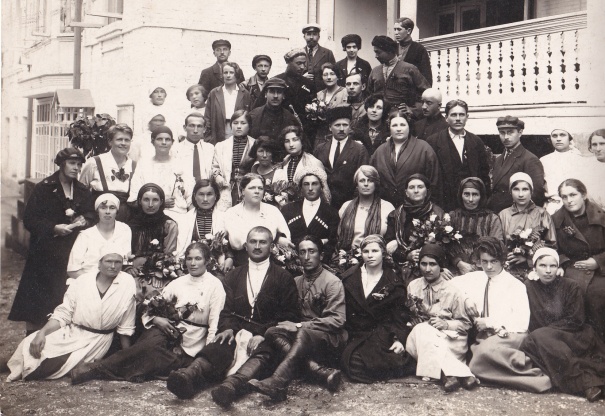
Leave a comment